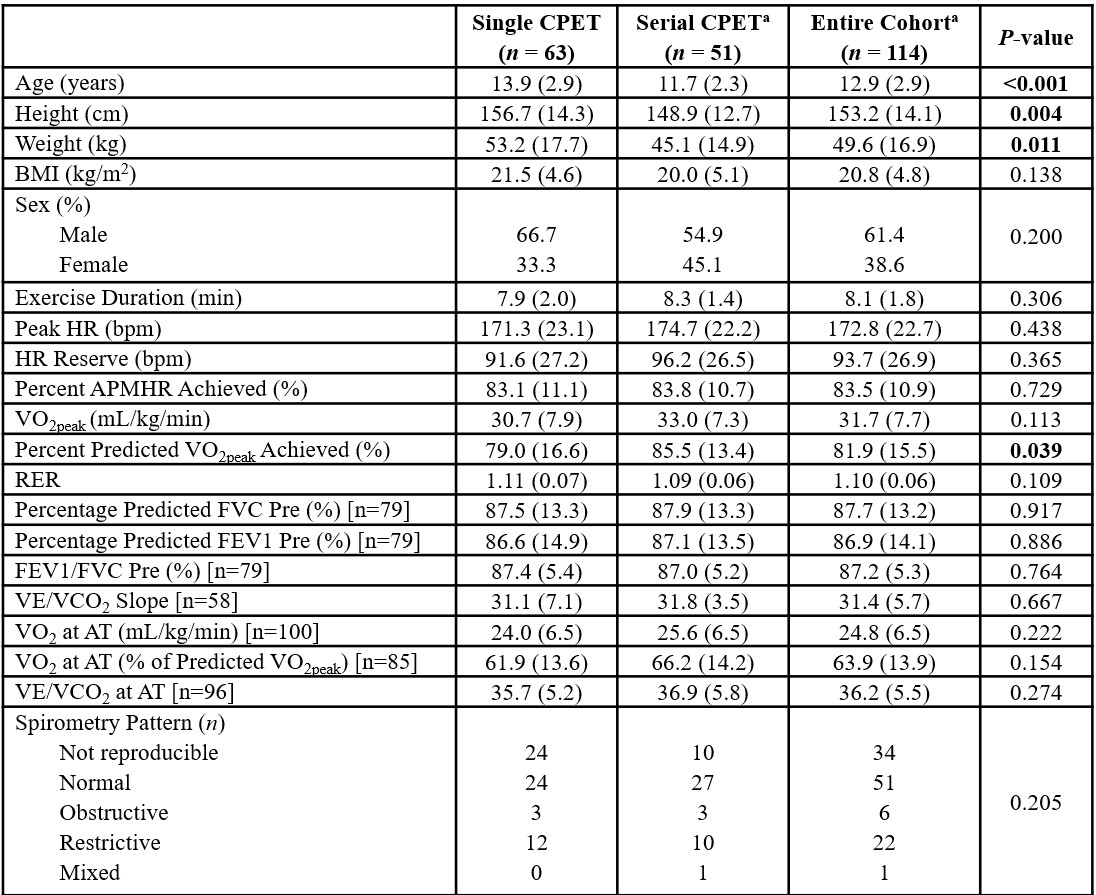Final ID: Sa2039
Prognostic Value of Cardiopulmonary Exercise Testing in a Contemporary Pediatric Fontan Cohort
Abstract Body (Do not enter title and authors here): Background: Peak exercise capacity via cardiopulmonary exercise testing (CPET) has been shown to have prognostic significance in adult Fontan patients.
Aims: The aim of this study was to determine the role of CPET in predicting death or need for transplantation in pediatric Fontan patients.
Hypothesis: We hypothesize that patients with lower baseline exercise capacity would have worse outcomes.
Methods: We performed a retrospective review of pediatric patients ≤ 18 years of age who had a lateral tunnel or extracardiac Fontan and underwent a CPET (respiratory exchange ratio ≥ 1.0) and spirometry between 2004 and 2022. Serial analysis was performed for patients with CPETs ≥ 2 years apart. Restrictive lung pattern was categorized as forced vital capacity (FVC) ≤ 80% predicted with a normal or increased forced expiratory volume in 1s (FEV1)/FVC, obstructive pattern as FEV1/FVC ≤ 80% predicted, and mixed pattern as FVC ≤ 80% predicted and FEV1/FVC ≤ 80%. Cardiovascular adverse events (CAE) included mortality or cardiac transplantation. Univariate regression analysis was performed.
Results: A total of 114 patients were included. The mean age at baseline CPET was 12.9 ± 2.9 years and average age at Fontan operation was 3.3 ± 1.7 years. The baseline peak oxygen consumption (VO2peak) was 31.7 ± 7.7mL/kg/min (83.5 ± 10.9% predicted) (Table 1). A total of 80/114 patients had reproducible spirometry with 51 (63.8%) being normal, 22 (27.5%) restrictive pattern, 6 (7.5%) obstructive pattern, and 1 (1.3%) mixed pattern. Serial CPETs were performed in 51 of 114 (44.7%) patients with a mean duration between CPETs of 3.5 ± 2.5 years. The percent predicted VO2peak changed by -0.73 ± 5.88% per year. A total of 15 out of 114 patients (13.2%) had CAE over a mean follow up of 7.8 ± 4.7 years. Each 1-minute increase in exercise duration achieved at baseline resulted in a 28.1% risk reduction in CAE.
Conclusion: Exercise capacity is maintained during the adolescent years in a contemporary cohort of pediatric Fontan patients. A higher baseline exercise duration is associated with a lower risk for future CAE. A majority of pediatric Fontan patients had normal spirometry.
Aims: The aim of this study was to determine the role of CPET in predicting death or need for transplantation in pediatric Fontan patients.
Hypothesis: We hypothesize that patients with lower baseline exercise capacity would have worse outcomes.
Methods: We performed a retrospective review of pediatric patients ≤ 18 years of age who had a lateral tunnel or extracardiac Fontan and underwent a CPET (respiratory exchange ratio ≥ 1.0) and spirometry between 2004 and 2022. Serial analysis was performed for patients with CPETs ≥ 2 years apart. Restrictive lung pattern was categorized as forced vital capacity (FVC) ≤ 80% predicted with a normal or increased forced expiratory volume in 1s (FEV1)/FVC, obstructive pattern as FEV1/FVC ≤ 80% predicted, and mixed pattern as FVC ≤ 80% predicted and FEV1/FVC ≤ 80%. Cardiovascular adverse events (CAE) included mortality or cardiac transplantation. Univariate regression analysis was performed.
Results: A total of 114 patients were included. The mean age at baseline CPET was 12.9 ± 2.9 years and average age at Fontan operation was 3.3 ± 1.7 years. The baseline peak oxygen consumption (VO2peak) was 31.7 ± 7.7mL/kg/min (83.5 ± 10.9% predicted) (Table 1). A total of 80/114 patients had reproducible spirometry with 51 (63.8%) being normal, 22 (27.5%) restrictive pattern, 6 (7.5%) obstructive pattern, and 1 (1.3%) mixed pattern. Serial CPETs were performed in 51 of 114 (44.7%) patients with a mean duration between CPETs of 3.5 ± 2.5 years. The percent predicted VO2peak changed by -0.73 ± 5.88% per year. A total of 15 out of 114 patients (13.2%) had CAE over a mean follow up of 7.8 ± 4.7 years. Each 1-minute increase in exercise duration achieved at baseline resulted in a 28.1% risk reduction in CAE.
Conclusion: Exercise capacity is maintained during the adolescent years in a contemporary cohort of pediatric Fontan patients. A higher baseline exercise duration is associated with a lower risk for future CAE. A majority of pediatric Fontan patients had normal spirometry.
More abstracts on this topic:
Angiotensin Converting Enzyme Gene Polymorphisms (ACE-I/D) Do Not Predict Exercise-Induced Cardiac Remodeling or Performance in Adolescent Male Athletes
Becker Kristian, Hardie William, Gubanich Paul, Hill Garick, Logan Kelsey, Martin Lisa, Powell Adam
Immunologic Insights: Activated and Exhausted Circulating T-Cell Phenotype in Hypoplastic Left Heart Syndrome (HLHS)Kumah Yvonne, Garcia Anastacia, Abbott Jordan, Lang Julie, Nakano Stephanie

